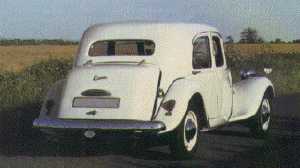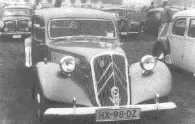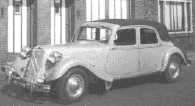
|
A Short History of the Citroën Traction Avant
|

|


Last updated:
December 25th 2000
Contact
![]()
|
Dieser Artikel ist auch auf Deutsch vorhanden.
Technologically Avant-garde Automobiles Citroën has made it a habit to be at the forefront with the newest technological inventions. This began in the year of the company's foundation, 1919, as the Type A was presented: it was one of the first cars to be delivered with bodywork, electric starter, and electric lights. At that time it was normal for the client to buy a bare chassis from the manufacturer and to take that to a coachbuilder to have the bodywork of choice mounted onto it. The Type A was also one of the first European cars to be built on an assembly line following the practice of the construction of the famous Ford Model T (Tin Lizzie). With the presentation of the Type C2 in the year 1922, Citroën offered a kind of 'Volkswagen'. It was a small car that did not need much technical understanding, had enough space for two people, and was easy to drive. The car was sold in yellow only in the beginning and since that time these particular Citroëns models have been known by the name 'lemon' (in French, "citron"...). By the way, a short time after Citroën, the German company Opel presented a car that looked almost identical to the C2. It was called the "tree-frog" as it was delivered only in green. At Citroën, the company's progress continued in 1925 with the introduction of the 'tout acier' (all steel) bodies. As the first manufacturer in Europe to use this process, Citroën introduced this way to build a car body with the type B10, replacing the nailing of sheet metal to a wooden frame. In 1932 Citroën introduced the flexible engine suspension, following a Chrysler patent. The transmission of the engine vibrations to the body was reduced dramatically by the use of rubber motor mounts. The Birth of the Traction Avant
In the year 1933, Citroën had need of a totally new model despite all its financial problems. It would be a revolutionary automobile. The features wanted in the new model included the following: 100 km/h maximum speed, a consumption of 10 litres / 100 km, uni-body construction, front-wheel drive, and automatic gearbox. To realize these plans, Citroën engaged André Lefèbvre as engineer for the project. Flamino Bertoni was responsible for the design of the car (no relationship to Nuccio Bertone , who also does contract work for Citroën). The first prototypes were soon prepared and ready for testing. The automatic gearbox showed many problems, but the rest of the car seemed fine. Within three weeks, a new manual gearbox was designed, with three forward and one reverse gear.
On March 3rd 1934 the Type 7 ("7" indicating the fiscal horse power - related to the engine size of 1303 cc) was presented to the dealers and it was a sensation - uni-body, front-wheel drive, independently sprung front wheels, torsion bar suspension, hydraulic brakes, rubber motor mounts for the engine, and so on. Compared to what was on the roads at the time, the car was very low. Thanks to the way it was built, it had no running boards. The road-holding and the way the power was transferred to the road were described as outstanding. The Traction Avant in Production First, a short explanation for the term 'Traction Avant': It means front-wheel drive and was used by Citroën to distinguish the new models from the models still in production with the same fiscal horse power, but rear wheel drive (Propulsion Arrière). Most people soon adopted the new term and the revolutionary cars became called, simply 'Tractions'. In the beginning, only the 'small' body was produced (overall length: 4.45 m) in Berline, Cabriolet, and Faux Cabriolet versions. The engine grew from 1303 cc to 1629 cc to what would have been a 9CV. But as Citroën had invested a great deal of money into the marketing campaign to launch the new '7' they kept that name.
The first sedans were distinguished from later versions by the roof being made of moleskine (an early artificial leather). The art of welding was not far enough advanced to make a steel roof to the high standards of the rest of the car. The boot was accessible only from the inside. Up to the beginning of WWII the Tractions were delivered in a large variety of colours - nothing about a Traction having to be black! For the Paris Motor Show in October 1934, Citroën presented the 'big' body with a 1911 cc engine, the type we know today as the 'Normale' or 'Large'. The body is 12 cm wider and 20 cm longer than the small one with similar technical specifications. The small body was now called the 'Légère'. At the same Motor Show, Citroën showed the 22 CV with a 3.8 litre V8 engine. With only very few prototypes being built, the car never reached production. Today, every Tractionist dreams of owning one of these rareties. Unfortunately, no original car is known to exist in the world.
The body of the Normale was built in the same versions as the Légère (Berline, Cabriolet, and Faux Cabriolet). Two new variants, the 'Conduite Intérieure' and the 'Familiale' were added. They were 20 cm longer again and had a third side window. The Familiale had a third row of seats which could be folded into place, making it a 9-seater. In 1936, all models got a boot that was accessible from the rear as well as high-tech rack-and-pinion steering. 1938 saw the presentation of the 6-cylinder model: 2 cylinders were added to the 1911 cc 4-cylinder engine giving a capacity of 2867 cc. Derived from the fiscal horse power, the car was also called the 15CV or 15/6. Soon the car adopted the name, 'Reine de la Route' (Queen of the road (in French, cars are usually female)). Also in 1938, the now very rare 11CV 'Commerciale' was presented. From the outside this car is recognizable by the two part hatch door (similar to the pattern the DS estate or many American station wagons use). This model was of interest to craftsmen as both everyday transportation and a Sunday vehicle.
During WWII, the Tractions were a favourite of the French Résistance because of their agility and road holding. That's why it's quite difficult these days to find a pre-war Traction in reasonable condition. Most of them 'died' for the French people. In wartime, the production at Citroën was practically non existant. As far as possible, they produced for the French armed forces as well as many utility vehicles, and later on, during the occupation, the factory was forced to produce for Germany. In 1946, after the factory was reconstructed, production restarted slowly. The 'luxury' versions, 'Cabriolet' and 'Faux Cabriolet', were discontinued. Tires on the wheels were an extra cost! Only three models were available: the 11CV Légère, the 11CV Normale (Large) and the 15/6, all in a colour that can be described as 'nearly black'.
This was the situation up until 1952, except that Citroën was able to deliver a true black. In this year the range was 'modernised' and the only major body change took place: a big boot was added, similar to what all other cars already had. In 1954, even the colour choice grew - you were able to order 'gris perle' (grey) and 'bleu R.A.F.' (dark blue). Two body styles from the pre-war cars were reintroduced: the 11CV Normale in the Familiale and Commerciale variant (but now with a one piece hatch). The 15/6 was available as a Familiale.
With a new version of the 15/6 you could guess that Citroën was working on a totally new model: the car was available as a 15/6H (Hydraulique), equipped with a rear suspension that was "sprung" by means of pressurized hydraulic fluid. The amazing Citroën DS was waiting on the horizon! At the Paris Motor Show in 1955, the DS was presented to the public, but this is another story! The production of the 15/6 had already stopped. The last Citroën Traction Avant, an 11CV Familiale, was delivered on 25 July 1957, with no big fuss. Finally, it was just another outdated car.
Andreas Rutishauser
|
||||||||||||||||||||||||||||||||















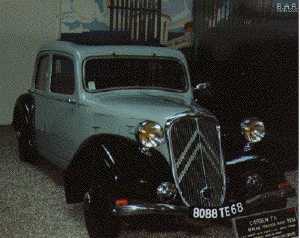
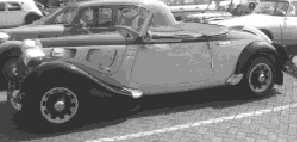
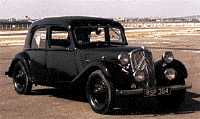

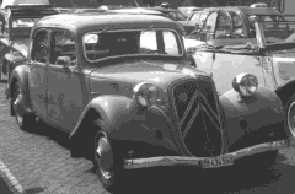
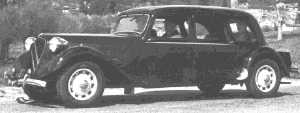
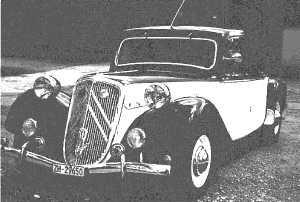 1946 wurde nach dem Wiederaufbau der Fabrik die Fertigung langsam wieder aufgenommen.
Die 'Luxuskarrosserien' Cabriolet und Faux Cabriolet strich man aus dem Programm.
Pneus auf den Rädern waren aufpreispflichtig! Nur 3 verschiedene Modelle konnten
gebaut werden, und auch diese nur in der Einheitsfarbe 'fastschwarz': die 11CV
Légère, die 11CV Normale (Large) und die 15/6.
1946 wurde nach dem Wiederaufbau der Fabrik die Fertigung langsam wieder aufgenommen.
Die 'Luxuskarrosserien' Cabriolet und Faux Cabriolet strich man aus dem Programm.
Pneus auf den Rädern waren aufpreispflichtig! Nur 3 verschiedene Modelle konnten
gebaut werden, und auch diese nur in der Einheitsfarbe 'fastschwarz': die 11CV
Légère, die 11CV Normale (Large) und die 15/6.
